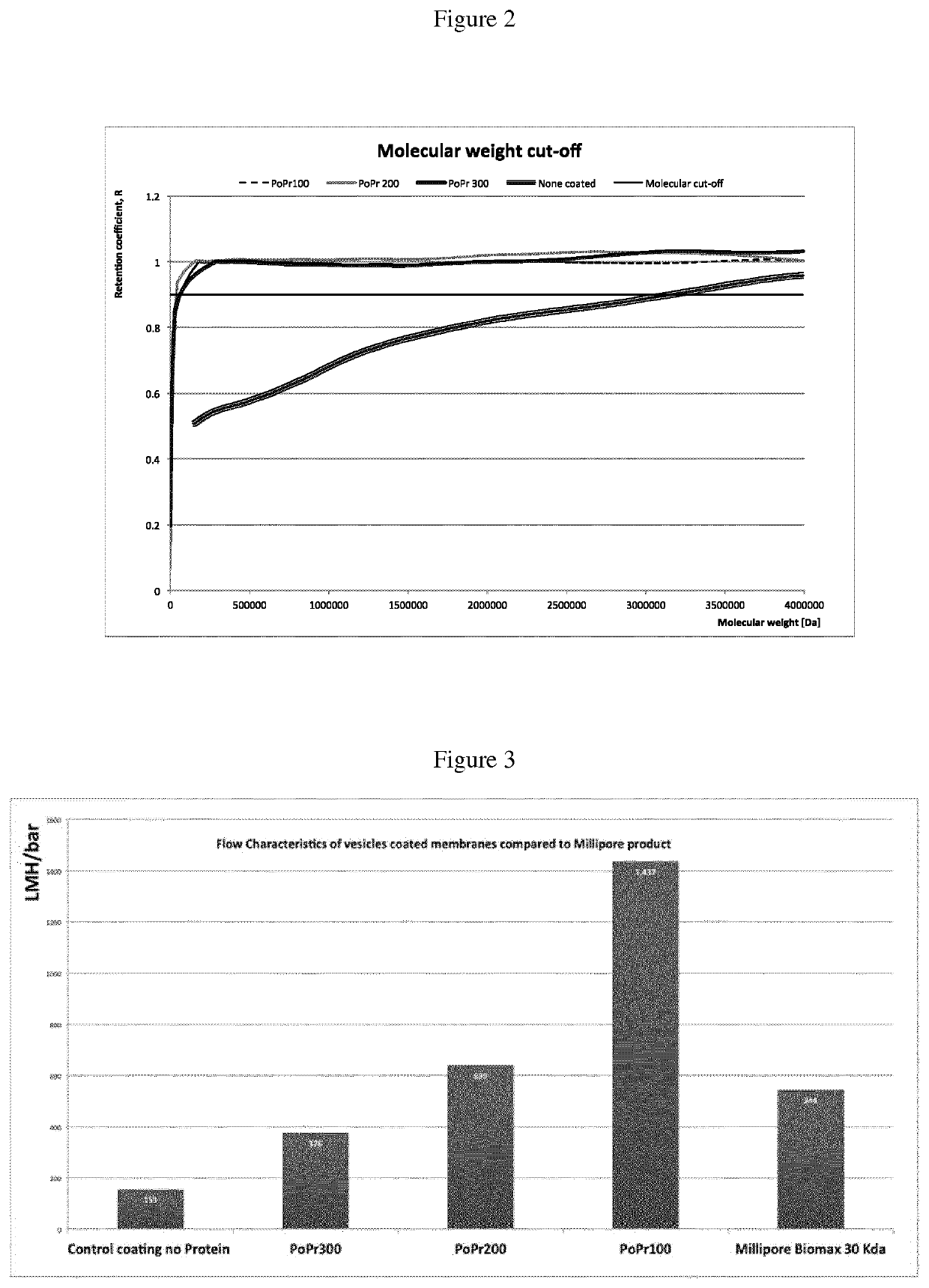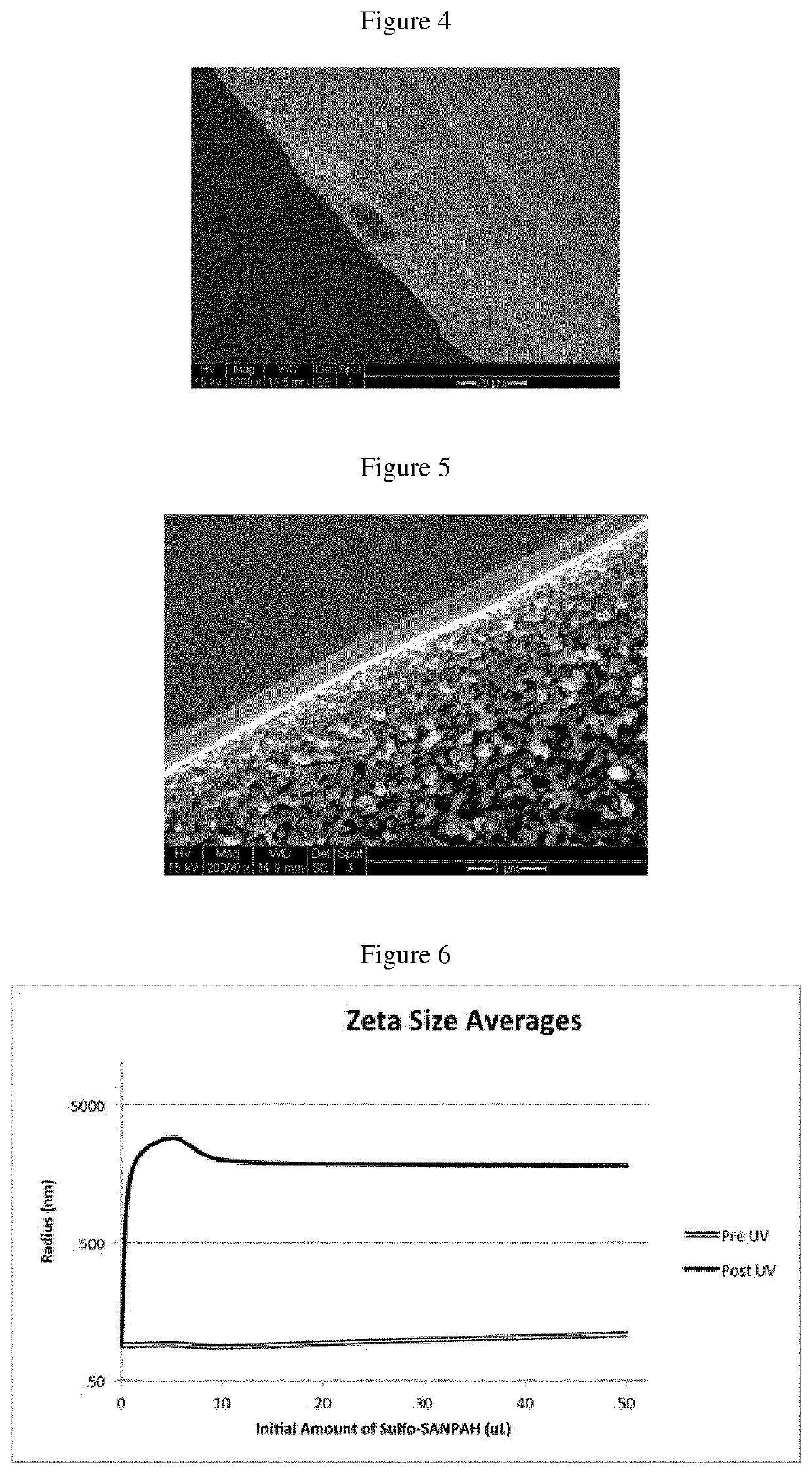Process for making membranes
a technology of membranes and imprinted polymers, applied in membrane technology, membrane technology, chemistry apparatus and processes, etc., can solve the problems of insufficient density of imprinted polymer layers to prevent all of solute and water molecules from permeating, and the inability to withstand the high hydrostatic pressure that is required,
- Summary
- Abstract
- Description
- Claims
- Application Information
AI Technical Summary
Benefits of technology
Problems solved by technology
Method used
Image
Examples
example 1
Materials:
[0573]2-methyl-2-oxazoline, Sigma[0574]Triethylamine, Sigma[0575]Hexane, anhydrous, Sigma[0576]Ethylene diamine, Sigma[0577]Trifluoromethanesulfonic acid, Sigma[0578]Ethyl acetate, Sigma[0579]Aquaporin-Z stock solution 1 mg / ml in 1% octyl glucoside and 100 mM NaMPOS buffer at pH 7.5[0580]100 mM NaMPOS buffer at pH 7.5[0581]Chloroform (Puriss)[0582]Octyl glucoside (Anatrace)[0583]Amine functional polymer vesicles 10 mg / mL in Na.MOPS[0584]PoPR (Polymer to Protein ratio, mass)[0585]N-sulfosuccinimidyl-6-(4′-aizido-2′-nitrophenylamino)hexanoate, sulfo-SANPAH (Pierce; Product No. 22589)[0586]Dextrans (American Polymer Standards Corporation)[0587]365 nm UV lamp (Entela UVP)[0588]47 mm Membrane stamp[0589]25 mm Membrane stamp[0590]Polysulfone membrane; pore size 150 nm (cut-off over 1000 kDa)
1) Polymer preparation—Primary / Secondary-Amine terminated poly-2-methyloxazoline-poly-di-methyl-siloxane-poly-2-methyloxazoline (PMOXA-PDMS-PMOXA)
Step a). α,ω-Hydroxy-butyl-poly-di-methyl-sil...
examples 2 and 3
[0612]Model experiments were carried out to confirm the suitability of various polymer end-groups for the preparation of vesicles and the covalent linking of vesicles to each other. The alternative polymers were prepared as follows.
(a) Carboxylic-terminated poly-2-methyloxazoline-poly-di-methyl-siloxane-poly-2-methyloxazoline (PMOXA-PDMS-PMOXA)
[0613]Hydroxyl-terminated polymer Mn=4262 g / mol (PDMS) synthesized as in step (a) of Example 1 was used in the synthesis of poly PMOXA-PDMS-PMOXA amphiphilic block copolymer. In a three-neck round bottom flask 50 grams (0.01173 mols) of PDMS was kept under high vacuum for 24 h. In the next step reaction the flask was filled with dry argon and polymer was dissolved in dry hexane (200 ml) added to the three-neck flask via septum. Cooled (0-5 deg C.) PDMS was than activated by drop-wise addition of 6.62 g (0.02346 mols) of trifluoromethanesulfonic anhydride in presence of 2.45 g (0.024 mols) of triethylamine and allowed to post-react for 3 hours....
example 2
[0616]250 μL of vesicles made from amine-terminated polymer as prepared in Example 1 were placed in a 64 mL clear glass vial, and protected from light by wrapping the vials in aluminum foil. The varying amounts (0, 1, 5, 10, 25 and 50 μl) of the difunctional linker sulfo-SANPAH, (10 mM Sulfo-SANPAH in 100 mM Na.MOPS pH 7.5) was added and mixed by gentle shaking Reaction was allowed to take place for 15 minutes, following which 100 μL of solution was placed into a cuvette for dynamic light scattering (DLS) measurement, DLS being a technique for the measurement of the size of particles in solution. The sample was placed about 5 cm below the UV lamp, the lid and foil were removed, the lamp was switched on, and the whole was covered with a foil tent. In all cases the attenuator was fixed at 6. After 15 minutes under UV,
[0617]Prior to reaction with sulfo-SANPAH, DLS showed the diameter of the vesicles to be 200 nm. After UV irradiation to cause reaction with sulfo-SANPAH, large aggregate...
PUM
| Property | Measurement | Unit |
|---|---|---|
| thickness | aaaaa | aaaaa |
| thickness | aaaaa | aaaaa |
| diameter | aaaaa | aaaaa |
Abstract
Description
Claims
Application Information
 Login to View More
Login to View More - R&D
- Intellectual Property
- Life Sciences
- Materials
- Tech Scout
- Unparalleled Data Quality
- Higher Quality Content
- 60% Fewer Hallucinations
Browse by: Latest US Patents, China's latest patents, Technical Efficacy Thesaurus, Application Domain, Technology Topic, Popular Technical Reports.
© 2025 PatSnap. All rights reserved.Legal|Privacy policy|Modern Slavery Act Transparency Statement|Sitemap|About US| Contact US: help@patsnap.com



